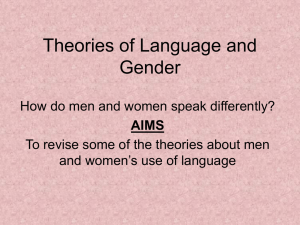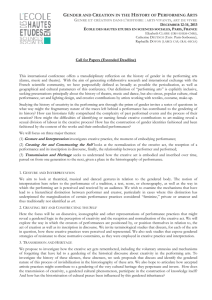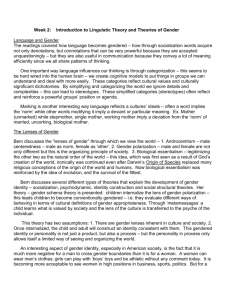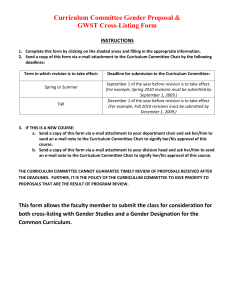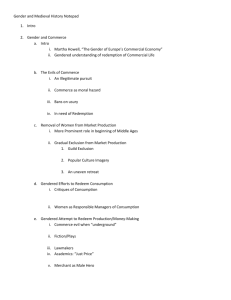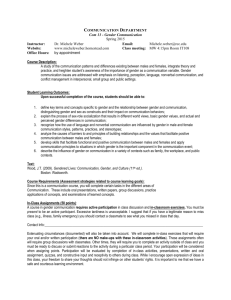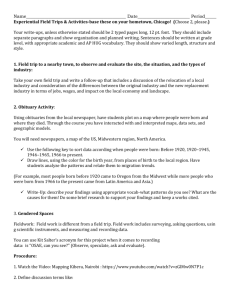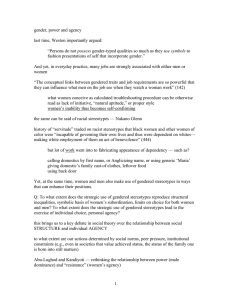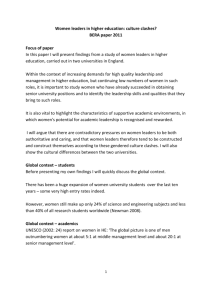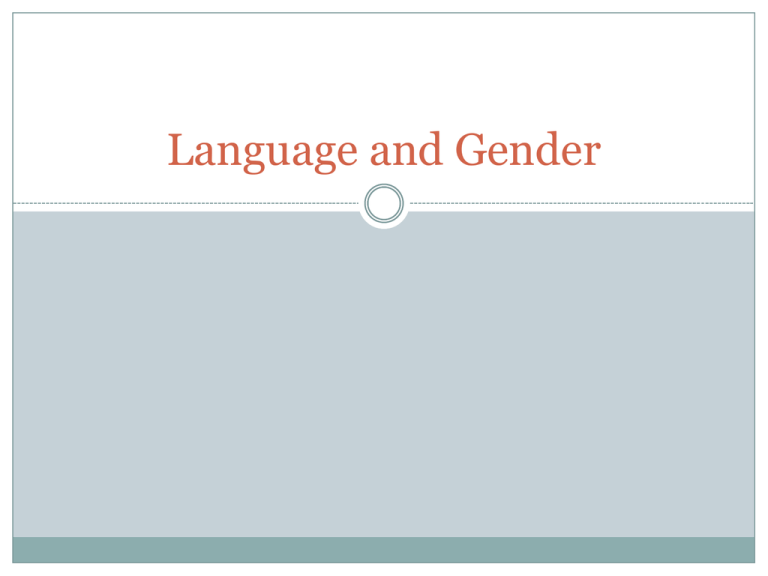
Language and Gender
Language and Gender is…
Language and gender is an area of study within
sociolinguistics, applied linguistics, and related fields
that investigates varieties of speech associated with a
particular gender, or social norms for such gendered
language use.
Sociolinguistics: is the descriptive study of the effect of any and all
aspects of society, including cultural norms, expectations, and context,
on the way language is used, and the effects of language use on society.
Applied Linguistics: is an interdisciplinary field of study that identifies,
investigates, and offers solutions to language-related real-life problems.
Studies of Language and Gender
Otto Jespersen (16 July 1860 – 30 April 1943)
was a Danish linguist who specialized in the grammar of the
English language.
Jespersen's contributions remain relevant. These include the
prospect of language change based on social and gendered
opportunity, lexical (words of language) and phonological
differences, and the idea of genderlects and gender roles
influence language.
Studies of Language and Gender
Robin Lakoff (born 1942)
identified a "women's register," which she argued served to
maintain women's (inferior) role in society.
Her view of women’s register included:
Tag Question: "You're John, aren't you?“
High Rising Intonation: is a feature of some accents of English
where statements have a rising intonation pattern in the final
syllable or syllables of the utterance.
Weak Directives: (directives) speech acts that are to cause the
hearer to take a particular action.
Studies of Gender and Language
Jennifer Coates
outlines the historical range of approaches to gendered speech
in her book Women, Men and Language. She contrasts the
four approaches known the deficit, dominance, difference, and
dynamic approaches.
Studies of Gender and Language
Deficit is an approach established by Lakoff (1975)
that introduces a 'women's language' as classified by
linguistic trends in women's speech. This approach
created a dichotomy between women's language and
men's language.
Dominance is an approach whereby the female sex is
seen as the subordinate group whose difference in
style of speech results from male supremacy and also
possibly an effect of patriarchy.
Studies of Gender and language
Difference is an approach of equality, differentiating
men and women as belonging to different 'subcultures' as they have been socialized to do so since
childhood. This then results in the varying
communicative styles of men and women.
Studies of Gender and Language
The "dynamic" or "social constructionist" approach
is, as Coates describes, the most current approach to
language and gender. Instead of speech falling into a
natural gendered category, the dynamic nature and
multiple factors of an interaction help a socially
appropriate gendered construct.
Speech Practices Associated With Gender
Minimal Responses: “mhm” and “yeah” are usually
used to communicate that you are listening. These
are used less frequently by men and mostly to show
agreement.
Questions: Men and women differ in their use of
questions in conversations. For men, a question is
usually a genuine request for information whereas
with women it can often be a rhetorical means of
engaging the other’s conversational contribution or
of acquiring attention from others conversationally
involved.
Speech Practices Associated With Gender
Turn Taking: women are more likely to encourage
turn-taking in a conversation, while men are more
focused on their own points of view.
Changing the Topic of Conversation: According to
Bruce Dorval in his study of same-sex friend
interaction, males tend to change subject more
frequently than females. This difference may well be
at the root of the conception that women chatter and
talk too much, and may still trigger the same
thinking in some males.
Speech Practices Associated With Gender
Self-Disclosure: Female tendencies toward self-
disclosure, i.e., sharing their problems and experiences
with others, often to offer sympathy, contrasts with male
tendencies to non-self disclosure and professing advice
or offering a solution when confronted with another’s
problems.
Verbal Aggression: For years, all research on aggression
focused primarily on males because it was believed
females were non-confrontational. Recently however,
people have realized that while "boys tend to be more
overtly and physically aggressive, girls are more
indirectly, socially, and relationally aggressive."
Speech Practices Associated With Gender
Listening and Attentiveness: It appears that women
attach more weight than men to the importance of
listening in conversation, with its connotations of
power to the listener as confidant of the speaker.
Men, however, interrupt far more frequently with
non-related topics, especially in the mixed sex
setting and, far from rendering a female speaker's
responses minimal, are apt to greet her
conversational spotlights with silence
Speech Practices Associated With Gender
Dominance vs. Subjection: Men desire
conversational dominance while women want to
participate in group conversation.
Politeness: Lakoff (1975) identified three forms of
politeness: formal, deference, and camaraderie.
Women's language is characterized by formal and
deference politeness, whereas men’s language is
exemplified by camaraderie.
(Women are usually more polite, while Men require rapport in
before initiating politeness. )

